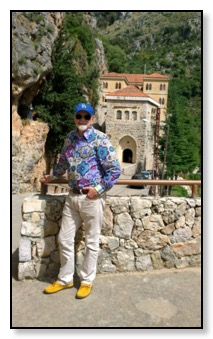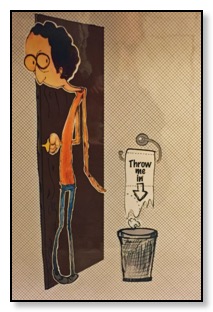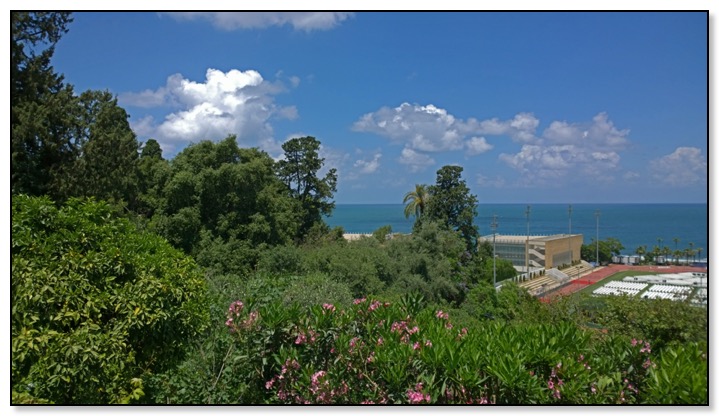Red light cedar preserves Lebanon monastery traffic
owever, that regular readers, shocked by the news that my trip to Lebanon went smoothly, are undoubtedly waiting for news of a flawed return. So:
Nazy and I were checking-in at the Beirut Airport in plenty of time for our conveniently scheduled 4:30AM departure. Although we were leaving on the same airplane (to Frankfurt), we had different routings for the final leg. The counter-clerk noticed after checking-in Nazy…
“You!” He said pointing at me. “You had a bad travel agent.”
“He didn't use a travel agent,” Nazy interjected. “He did the flight arrangements all by himself.”
“I can see that,” the clerk replied with a smirk.
Nazy was booked from Beirut to Frankfurt to Los Angeles. I, on the other hand, went Beirut-Frankfurt-Zurich-Los Angeles. And, my Zurich flight, scheduled for 12:30PM was, at 3:00AM already delayed. When I arrived in Zurich, the departure board listed the Los Angeles flight as (naturally) the only one with a delay. I found an airport hotel that charged by the hour, grabbed a few hours of sleep and arrived in Los Angeles about 10 hours after Nazy. Although I hadn’t flown for almost two years, it was nice that Swiss remembered to treat me the same as always.
Anyone visiting Lebanon from almost anywhere will notice the challenging traffic and driving conditions. Lebanese claim that the traffic, tradition and culture of the country means that their drivers are the best in the world. They cope with potholes, heavy traffic, close quarters, crazed motorcycle riders, double parking, occasional check points and, until recently, a complete disregard for regulation. In fact, during our first few trips to Beirut, we never observed any car voluntarily stopping at any red-light. Things..

“… have changed, Dad.” Darius explained. “In phase I of the new traffic policy, the police started giving tickets to people who don’t stop at traffic lights. They also ticket people who talk on the mobile phone while driving.”
“I guess Melika won’t be renting a car in Beirut.”
“Even Christiane got a ticket. And next week, they’re beginning phase 2. Cars will have to stop at zebra crossings and there will be tickets for excessive horn honking.”
“What?” I said. “Who will retrain the local drivers?” I thought.
Afraid of adverse health impacts from excesses of adrenalin, I wisely avoided driving. Luckily, Christiane cheerfully drove us around the country. Early in our trip, she drove us to Deir Qozhaya (which houses a monastery and the first printing press in the Middle East) and Horsh Ehden, a cedar preserve in the North of the country. We were heading out of Beirut. I was marveling at the minuscule space between cars when a truck knocked the outside mirror off of a car in front of us. Prudently, I moved toward the center of Christiane’s car.
Veracity note: I was in a taxi in NYC in 1987. We were in the 34th street tunnel (the Queens-Midtown Tunnel). Traffic was heavy. My taxi attempted to squeeze between two cars. It scraped the sides of both. I now conclude that the driver was from Beirut and had been trained on trucks.
The Monastery of St. Anthony the Great is at Deir Qozhaya. it was built in the 12th Century and houses the oldest printing press (installed in the late 1500s) in the Middle East. It is located in the mountains in the northern part of Lebanon. It wasn’t easy to find. Google Maps doesn’t work in Lebanon and addresses aren’t handled the conventional way. (Many streets don’t have names.) Christiane wasn’t phased. She asked for directions several times - everyone was pleasant and most were helpful. (One guy did give bogus directions and told her to light a candle for Darius when she found the Monastery.)
There was a very old printing press in the museum - and copies of bibles printed with the device. The mountains were beautiful and the chapel, carved into the rocky cliffs, was stunning.

From the monastery, we headed toward the cedar preserve in Horsh Ehden. The Cedar is the symbol of Lebanon. It’s on the flag and is the logo of Middle East Airlines. Cedar is mentioned in the Bible 75 times. There has been significant deforestation in Lebanon: e.g. cedar has been used in palaces (King Solomon), Mummification resin (the Pharaohs) and commercial ships (Phoenicians). Almost as long as cedars have met people, there have been projects (from Hadrian to Queen Victoria) to protect the tree.
On the drive home, we had dinner at Pierre and Friends in Al Batrun. (Christiane knows all the cool places.) We watched the sunset and spotted Venus, Jupiter and Saturn over the Med. It was a very fun and full day.
While Darius worked on his research papers, Christiane drove us to the St. Charabel Monestary in Annaya. It’s also in a beautiful part of Lebanon - a part that we had not seen before. This time we lit a candle for Darius’ research. (I also lit a candle for traffic safety.)
In general, this trip showed us an expanded view of Beirut and Lebanon. Darius, for example, has moved into an apartment that has electricity - 24 hours a day! It features a cleaning service, fully functional air conditioning, a relatively fast internet, peel-less paint. It’s
“Wonderful, Dar.” I enthused. “I can see Christiane’s influence,” I thought.
There was one minor challenge. The Beirut sewers are not equipped to handle toilet paper - and you are constantly reminded to not put paper in the toilets. (Thankfully, bidets are always available.) Because we are from drought-stricken Santa Barbara where water-efficient toilets sometimes have trouble with paper, we coped easily.

The cuisine was far more varied and tasty than in previous visits. In addition to the feast hosted by Christiane’s parents, we had great sunset dinners in Byblos and Al Batrun. We enjoyed Armenian food and sampled a variety of great restaurants during the week. And, just before we were leaving, we had brunch Paul by the yacht club location, dinner at Cru, a French restaurant in Beirut.
We also went to the top of the Four Seasons Hotel (to the appropriately named bar, ‘The Roof&rsquo for after dinner drinks. The Roof, on the 26th floor, has both indoor and outdoor seating. It is elegant and very trendy. Darius and Christiane fit right into the ‘in-crowd’.
for after dinner drinks. The Roof, on the 26th floor, has both indoor and outdoor seating. It is elegant and very trendy. Darius and Christiane fit right into the ‘in-crowd’.
Nazy and I were checking-in at the Beirut Airport in plenty of time for our conveniently scheduled 4:30AM departure. Although we were leaving on the same airplane (to Frankfurt), we had different routings for the final leg. The counter-clerk noticed after checking-in Nazy…
“You!” He said pointing at me. “You had a bad travel agent.”
“He didn't use a travel agent,” Nazy interjected. “He did the flight arrangements all by himself.”
“I can see that,” the clerk replied with a smirk.
Nazy was booked from Beirut to Frankfurt to Los Angeles. I, on the other hand, went Beirut-Frankfurt-Zurich-Los Angeles. And, my Zurich flight, scheduled for 12:30PM was, at 3:00AM already delayed. When I arrived in Zurich, the departure board listed the Los Angeles flight as (naturally) the only one with a delay. I found an airport hotel that charged by the hour, grabbed a few hours of sleep and arrived in Los Angeles about 10 hours after Nazy. Although I hadn’t flown for almost two years, it was nice that Swiss remembered to treat me the same as always.
Anyone visiting Lebanon from almost anywhere will notice the challenging traffic and driving conditions. Lebanese claim that the traffic, tradition and culture of the country means that their drivers are the best in the world. They cope with potholes, heavy traffic, close quarters, crazed motorcycle riders, double parking, occasional check points and, until recently, a complete disregard for regulation. In fact, during our first few trips to Beirut, we never observed any car voluntarily stopping at any red-light. Things..

“… have changed, Dad.” Darius explained. “In phase I of the new traffic policy, the police started giving tickets to people who don’t stop at traffic lights. They also ticket people who talk on the mobile phone while driving.”
“I guess Melika won’t be renting a car in Beirut.”
“Even Christiane got a ticket. And next week, they’re beginning phase 2. Cars will have to stop at zebra crossings and there will be tickets for excessive horn honking.”
“What?” I said. “Who will retrain the local drivers?” I thought.
Afraid of adverse health impacts from excesses of adrenalin, I wisely avoided driving. Luckily, Christiane cheerfully drove us around the country. Early in our trip, she drove us to Deir Qozhaya (which houses a monastery and the first printing press in the Middle East) and Horsh Ehden, a cedar preserve in the North of the country. We were heading out of Beirut. I was marveling at the minuscule space between cars when a truck knocked the outside mirror off of a car in front of us. Prudently, I moved toward the center of Christiane’s car.
Veracity note: I was in a taxi in NYC in 1987. We were in the 34th street tunnel (the Queens-Midtown Tunnel). Traffic was heavy. My taxi attempted to squeeze between two cars. It scraped the sides of both. I now conclude that the driver was from Beirut and had been trained on trucks.
The Monastery of St. Anthony the Great is at Deir Qozhaya. it was built in the 12th Century and houses the oldest printing press (installed in the late 1500s) in the Middle East. It is located in the mountains in the northern part of Lebanon. It wasn’t easy to find. Google Maps doesn’t work in Lebanon and addresses aren’t handled the conventional way. (Many streets don’t have names.) Christiane wasn’t phased. She asked for directions several times - everyone was pleasant and most were helpful. (One guy did give bogus directions and told her to light a candle for Darius when she found the Monastery.)
There was a very old printing press in the museum - and copies of bibles printed with the device. The mountains were beautiful and the chapel, carved into the rocky cliffs, was stunning.

From the monastery, we headed toward the cedar preserve in Horsh Ehden. The Cedar is the symbol of Lebanon. It’s on the flag and is the logo of Middle East Airlines. Cedar is mentioned in the Bible 75 times. There has been significant deforestation in Lebanon: e.g. cedar has been used in palaces (King Solomon), Mummification resin (the Pharaohs) and commercial ships (Phoenicians). Almost as long as cedars have met people, there have been projects (from Hadrian to Queen Victoria) to protect the tree.
On the drive home, we had dinner at Pierre and Friends in Al Batrun. (Christiane knows all the cool places.) We watched the sunset and spotted Venus, Jupiter and Saturn over the Med. It was a very fun and full day.
While Darius worked on his research papers, Christiane drove us to the St. Charabel Monestary in Annaya. It’s also in a beautiful part of Lebanon - a part that we had not seen before. This time we lit a candle for Darius’ research. (I also lit a candle for traffic safety.)
In general, this trip showed us an expanded view of Beirut and Lebanon. Darius, for example, has moved into an apartment that has electricity - 24 hours a day! It features a cleaning service, fully functional air conditioning, a relatively fast internet, peel-less paint. It’s
“Wonderful, Dar.” I enthused. “I can see Christiane’s influence,” I thought.
There was one minor challenge. The Beirut sewers are not equipped to handle toilet paper - and you are constantly reminded to not put paper in the toilets. (Thankfully, bidets are always available.) Because we are from drought-stricken Santa Barbara where water-efficient toilets sometimes have trouble with paper, we coped easily.

The cuisine was far more varied and tasty than in previous visits. In addition to the feast hosted by Christiane’s parents, we had great sunset dinners in Byblos and Al Batrun. We enjoyed Armenian food and sampled a variety of great restaurants during the week. And, just before we were leaving, we had brunch Paul by the yacht club location, dinner at Cru, a French restaurant in Beirut.
We also went to the top of the Four Seasons Hotel (to the appropriately named bar, ‘The Roof&rsquo
For last week's letter, please click here
For photos from the trip please click here
The Med from the American University of Beirut
blog comments powered by Disqus

